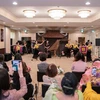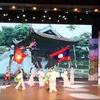 Lao Chai, Choan Then and Ban San villages are among the places where old rammed earth houses with thatch roofs still exist today. These houses are called ‘nha trinh tuong’, with 'nha' being house and 'tuong' being wall. 'Trinh' is derived from the word 'chinh', which means ‘pounded until firm’ in the language of local ethnic minorities. The walls made of earth have stood the test of time and fierce weather conditions and keep their owners warm in winter and cool in summer. While ‘trinh tuong’ houses are popular in Vietnam’s northern region, the houses of Ha Nhi people are square-shaped with their roofs tiled with thatch (Photo: VietnamPlus)
Lao Chai, Choan Then and Ban San villages are among the places where old rammed earth houses with thatch roofs still exist today. These houses are called ‘nha trinh tuong’, with 'nha' being house and 'tuong' being wall. 'Trinh' is derived from the word 'chinh', which means ‘pounded until firm’ in the language of local ethnic minorities. The walls made of earth have stood the test of time and fierce weather conditions and keep their owners warm in winter and cool in summer. While ‘trinh tuong’ houses are popular in Vietnam’s northern region, the houses of Ha Nhi people are square-shaped with their roofs tiled with thatch (Photo: VietnamPlus)  'Trinh truong’ houses here are similar to one another in terms of forms, structure, space planning and decoration. Each house often covers an area of 60 – 80 square metres, and the wall is 40 – 60 centimetres in thickness and 4 – 5 metres in height. The building of ‘trinh tuong’ houses starts at the end of the harvest season, from the eighth to the twelfth lunar month. It requires a lot of time, even 4 – 5 months, as well as efforts to complete a ‘trinh tuong’ house. Some houses have even been standing for a few hundred years, and now, they have become a magnet for visitors from far and wide (Photo: VietnamPlus)
'Trinh truong’ houses here are similar to one another in terms of forms, structure, space planning and decoration. Each house often covers an area of 60 – 80 square metres, and the wall is 40 – 60 centimetres in thickness and 4 – 5 metres in height. The building of ‘trinh tuong’ houses starts at the end of the harvest season, from the eighth to the twelfth lunar month. It requires a lot of time, even 4 – 5 months, as well as efforts to complete a ‘trinh tuong’ house. Some houses have even been standing for a few hundred years, and now, they have become a magnet for visitors from far and wide (Photo: VietnamPlus)  ‘Trinh truong’ houses here are similar to one another in terms of forms, structure, space planning and decoration. Each house often covers an area of 60 – 80 square metres, and the wall is 40 – 60 centimetres in thickness and 4 – 5 metres in height. The building of ‘trinh tuong’ houses starts at the end of the harvest season, from the eighth to the twelfth lunar month. It requires a lot of time, even 4 – 5 months, as well as efforts to complete a ‘trinh tuong’ house. Some houses have even been standing for a few hundred years, and now, they have become a magnet for visitors from far and wide (Photo: VietnamPlus)
‘Trinh truong’ houses here are similar to one another in terms of forms, structure, space planning and decoration. Each house often covers an area of 60 – 80 square metres, and the wall is 40 – 60 centimetres in thickness and 4 – 5 metres in height. The building of ‘trinh tuong’ houses starts at the end of the harvest season, from the eighth to the twelfth lunar month. It requires a lot of time, even 4 – 5 months, as well as efforts to complete a ‘trinh tuong’ house. Some houses have even been standing for a few hundred years, and now, they have become a magnet for visitors from far and wide (Photo: VietnamPlus)  Not only keeping roads tidy, residents in Choan Then village also have environmentally friendly waste baskets like this to ensure a clean living environment. The language of Ha Nhi people belongs to the Tibeto – Burmese language group. They live on rice cultivation of burnt-over land or terraced fields. They are one of the groups experienced in reclaiming terraced fields on mountain slopes, digging canals and building small dams. They use ploughs and harrows pulled by oxens or buffaloes to work the fields. Their animal husbandry, cloth weaving and basketry making are also developed. Most of the Ha Nhi can make clothes for themselves (Photo: VietnamPlus)
Not only keeping roads tidy, residents in Choan Then village also have environmentally friendly waste baskets like this to ensure a clean living environment. The language of Ha Nhi people belongs to the Tibeto – Burmese language group. They live on rice cultivation of burnt-over land or terraced fields. They are one of the groups experienced in reclaiming terraced fields on mountain slopes, digging canals and building small dams. They use ploughs and harrows pulled by oxens or buffaloes to work the fields. Their animal husbandry, cloth weaving and basketry making are also developed. Most of the Ha Nhi can make clothes for themselves (Photo: VietnamPlus)  Wild flowers are popular toys of children here. Y Ty has become an appealing destination for local and international tourists thanks to its beautiful paddy fields and traditional forest-worship rituals. About 80 kilometres north of Lao Cai city, this commune is made up of mountainous terrain with steep slopes and a tough climate, with many streams that make it difficult for locals to farm any grain variety. To adapt, locals created terraced paddy fields, with each generation expanding them, one on top of the other hugging mountains. At 2,000 metres above sea level and wrapped in mist and clouds, the terraced paddy fields impress visitors with a beautiful view of where sky meets earth (Photo: VietnamPlus)
Wild flowers are popular toys of children here. Y Ty has become an appealing destination for local and international tourists thanks to its beautiful paddy fields and traditional forest-worship rituals. About 80 kilometres north of Lao Cai city, this commune is made up of mountainous terrain with steep slopes and a tough climate, with many streams that make it difficult for locals to farm any grain variety. To adapt, locals created terraced paddy fields, with each generation expanding them, one on top of the other hugging mountains. At 2,000 metres above sea level and wrapped in mist and clouds, the terraced paddy fields impress visitors with a beautiful view of where sky meets earth (Photo: VietnamPlus)  Houses with bright yellow earth walls stand out in mountains and forests. Y Ty in Bat Xat district, about 70 km to the north of renowned resort town Sa Pa, is rather isolated due to high surrounding mountains. It is famed among Vietnamese trekkers for its beautiful scenery at cloud level. The commune, which is 2,000 metres above sea level, is home to H’mong, Dao, Giay and Ha Nhi ethnic minority groups. Y Ty is beautiful throughout the year though September and October are considered the best months to visit as the rice paddies will turn yellow dotted with houses with wooden roofs (Photo: VietnamPlus)
Houses with bright yellow earth walls stand out in mountains and forests. Y Ty in Bat Xat district, about 70 km to the north of renowned resort town Sa Pa, is rather isolated due to high surrounding mountains. It is famed among Vietnamese trekkers for its beautiful scenery at cloud level. The commune, which is 2,000 metres above sea level, is home to H’mong, Dao, Giay and Ha Nhi ethnic minority groups. Y Ty is beautiful throughout the year though September and October are considered the best months to visit as the rice paddies will turn yellow dotted with houses with wooden roofs (Photo: VietnamPlus)  ‘Trinh tuong’ houses feature earth walls about 4 – 5 metres high. The building of ‘trinh tuong’ houses start at the end of the crop season, from the eighth to the twelfth lunar month. The construction starts with the building and setup of a stone foundation. Then, clay is compressed into moulds to make walls for the house. A mould is 2 – 2.5 metres in length and 60 centimetres in width. This is the most difficult step in the home building process. Although all steps are done manually without cement, these houses are very solid and firm. They have small doors and windows to prevent cold fog, winds and rains from entering (Photo: VietnamPlus)
‘Trinh tuong’ houses feature earth walls about 4 – 5 metres high. The building of ‘trinh tuong’ houses start at the end of the crop season, from the eighth to the twelfth lunar month. The construction starts with the building and setup of a stone foundation. Then, clay is compressed into moulds to make walls for the house. A mould is 2 – 2.5 metres in length and 60 centimetres in width. This is the most difficult step in the home building process. Although all steps are done manually without cement, these houses are very solid and firm. They have small doors and windows to prevent cold fog, winds and rains from entering (Photo: VietnamPlus)  Behind the main door, a wall as thick as the outer one appears. It is where Ha Nhi people hang daily tools and keepsakes. Behind this wall are the kitchen and beds of house owners. This is the common space planning of Ha Nhi people, regardless of whether they are rich or poor. Covering an area of 60 – 80 square metres, each rammed earth house has four sloping short roofs made of thatch. Nowadays, corrugated iron sheets are the popular material forming the roofs of new ‘trinh tuong’ houses. Each house has only one door in the middle and one or two small windows in the left or the right of the door (Photo: VietnamPlus)
Behind the main door, a wall as thick as the outer one appears. It is where Ha Nhi people hang daily tools and keepsakes. Behind this wall are the kitchen and beds of house owners. This is the common space planning of Ha Nhi people, regardless of whether they are rich or poor. Covering an area of 60 – 80 square metres, each rammed earth house has four sloping short roofs made of thatch. Nowadays, corrugated iron sheets are the popular material forming the roofs of new ‘trinh tuong’ houses. Each house has only one door in the middle and one or two small windows in the left or the right of the door (Photo: VietnamPlus)  Each rammed earth house covers an area of 60 – 80 square metres. Its wall is 40 – 60 centimetres in thickness and 4 – 5 metres in height. The building of ‘trinh tuong’ houses start at the end of the crop season, from the eighth to the twelfth lunar month. It requires a lot of time, even 4 – 5 months, as well as efforts to complete a ‘trinh tuong’ house. Ha Nhi people often come to assist their neighbours and relatives to build houses. They gather in villages with about 50 – 60 households each and farm wet rice, crops and livestock as the main livelihoods (Photo: VietnamPlus)
Each rammed earth house covers an area of 60 – 80 square metres. Its wall is 40 – 60 centimetres in thickness and 4 – 5 metres in height. The building of ‘trinh tuong’ houses start at the end of the crop season, from the eighth to the twelfth lunar month. It requires a lot of time, even 4 – 5 months, as well as efforts to complete a ‘trinh tuong’ house. Ha Nhi people often come to assist their neighbours and relatives to build houses. They gather in villages with about 50 – 60 households each and farm wet rice, crops and livestock as the main livelihoods (Photo: VietnamPlus)  Rammed earth houses provide a shelter that is cool in summer and warm in winter for their owners. They have also become a unique architectural identity of the Ha Nhi ethnic community. Here in Y Ty, the area is covered by clouds clinging to the side of mountains in winter, looking like a heaven of fairies. The white colour is replaced by pink of the Do Quyen (rhododendron) flower in full bloom in spring. As summer comes, the grey paddy fields seem to be covered in a new cloth by the skillful and industrious hands of locals. In September and October, when Y Ty is most beautiful, the rice paddies turn yellow dotted with houses with wooden roofs (Photo: VietnamPlus)
Rammed earth houses provide a shelter that is cool in summer and warm in winter for their owners. They have also become a unique architectural identity of the Ha Nhi ethnic community. Here in Y Ty, the area is covered by clouds clinging to the side of mountains in winter, looking like a heaven of fairies. The white colour is replaced by pink of the Do Quyen (rhododendron) flower in full bloom in spring. As summer comes, the grey paddy fields seem to be covered in a new cloth by the skillful and industrious hands of locals. In September and October, when Y Ty is most beautiful, the rice paddies turn yellow dotted with houses with wooden roofs (Photo: VietnamPlus)  Aside from rammed earth houses and beautiful terraced paddy fields, communities in Y Ty commune also boasts traditions of great significance. Among those traditions is the forest-worshipping ritual or ‘Ga Ma Do’ of the Ha Nhi people. This ritual is observed in the first lunar month to pray for peace, favourable weather, bountiful harvest, and prosperity. Each hamlet of Ha Nhi people has a sacred forest to worship the forest god who protects the village, and they believe that all trees and animals in the forest have soul. With all of these identities, Y Ty is worthy of a visit for any tourist (Photo: VietnamPlus)
Aside from rammed earth houses and beautiful terraced paddy fields, communities in Y Ty commune also boasts traditions of great significance. Among those traditions is the forest-worshipping ritual or ‘Ga Ma Do’ of the Ha Nhi people. This ritual is observed in the first lunar month to pray for peace, favourable weather, bountiful harvest, and prosperity. Each hamlet of Ha Nhi people has a sacred forest to worship the forest god who protects the village, and they believe that all trees and animals in the forest have soul. With all of these identities, Y Ty is worthy of a visit for any tourist (Photo: VietnamPlus)  A small window of a rammed earth house of Ha Nhi people. To have the best view of Y Ty’s cloud-covered region, it is recommended to travel from September to the following April during the dry season, with a possibility of snow. In early April, tourists will also be welcomed by blooming rhododendron trees, covering the region with a pink-violet shade. In May and June when summer rains begin, water flows to the fields, softening dry soil to allow locals to begin planting rice. The brown soil, sparkling water, sun rays and green rice seedlings all create a wondrous picture for tourists. From late August to October, visitors can experience the blooming golden terraced rice fields (Photo: VietnamPlus)
A small window of a rammed earth house of Ha Nhi people. To have the best view of Y Ty’s cloud-covered region, it is recommended to travel from September to the following April during the dry season, with a possibility of snow. In early April, tourists will also be welcomed by blooming rhododendron trees, covering the region with a pink-violet shade. In May and June when summer rains begin, water flows to the fields, softening dry soil to allow locals to begin planting rice. The brown soil, sparkling water, sun rays and green rice seedlings all create a wondrous picture for tourists. From late August to October, visitors can experience the blooming golden terraced rice fields (Photo: VietnamPlus)  A door of a ‘trinh tuong’ house. Y Ty commune of Lao Cai province is famed among Vietnamese trekkers for its beautiful scenery at cloud level. It was once selected as one of the Best-kept Secrets in Asia Travel by the travel site www.thrillist.com. This website said: “Y Ty sits atop Vietnam’s highest plateau, offering spectacular views of cloud-reaching mountains and yellow rice patty fields. If you want to experience rural Vietnam without straying far from the tourist centre of Sa Pa, this is your spot.” It noted that tourists should get to know locals at Y Ty’s market “where surrounding ethnic tribes sell traditional crafts and agricultural goods” (Photo: VietnamPlus)
A door of a ‘trinh tuong’ house. Y Ty commune of Lao Cai province is famed among Vietnamese trekkers for its beautiful scenery at cloud level. It was once selected as one of the Best-kept Secrets in Asia Travel by the travel site www.thrillist.com. This website said: “Y Ty sits atop Vietnam’s highest plateau, offering spectacular views of cloud-reaching mountains and yellow rice patty fields. If you want to experience rural Vietnam without straying far from the tourist centre of Sa Pa, this is your spot.” It noted that tourists should get to know locals at Y Ty’s market “where surrounding ethnic tribes sell traditional crafts and agricultural goods” (Photo: VietnamPlus)  Rammed earth houses glow yellow in summer light but seem to be melancholic in the coverage of fog of the winter. ‘Trinh tuong’ houses form a characteristic of Y Ty. Seeing humble these rammed earth houses by the side of terraced fields is like seeing a well-arranged picture. That is the reason why many people wish to come to the area dubbed “the land of clouds”. The Ha Nhi people, known to be diligent, live close to nature, which may be the reason why their costume is mainly green, very close to the colour of the mountains and forests in the northwest of Vietnam (Photo: VietnamPlus)
Rammed earth houses glow yellow in summer light but seem to be melancholic in the coverage of fog of the winter. ‘Trinh tuong’ houses form a characteristic of Y Ty. Seeing humble these rammed earth houses by the side of terraced fields is like seeing a well-arranged picture. That is the reason why many people wish to come to the area dubbed “the land of clouds”. The Ha Nhi people, known to be diligent, live close to nature, which may be the reason why their costume is mainly green, very close to the colour of the mountains and forests in the northwest of Vietnam (Photo: VietnamPlus)  Children sit on the doorstep of a ‘trinh tuong’ house to wait for adults to return from work. Small doors and windows are meant to help the houses steer clear of the cold in winter. As houses are made of earth, the construction is carried out only in the dry season, from the eighth to the 12th lunar month. Despite being made of earth, many ‘trinh tuong’ houses that exist in Y Ty commune today date back to a few hundreds of years ago. Only this type of houses is tolerant of the harsh climate conditions, cold and foggy, in this northern mountainous land (Photo: VietnamPlus)
Children sit on the doorstep of a ‘trinh tuong’ house to wait for adults to return from work. Small doors and windows are meant to help the houses steer clear of the cold in winter. As houses are made of earth, the construction is carried out only in the dry season, from the eighth to the 12th lunar month. Despite being made of earth, many ‘trinh tuong’ houses that exist in Y Ty commune today date back to a few hundreds of years ago. Only this type of houses is tolerant of the harsh climate conditions, cold and foggy, in this northern mountainous land (Photo: VietnamPlus)  In the past, Ha Nhi people often collected thatch in the forest or use rice straw to make layers of cover that could be up to 50 centimertres thick on the top of their ‘trinh tuong’ houses. The thatch roofs help these houses to be cool in summer and warm in winter. Nowadays, as local living standards have been improving, Ha Nhi people have also replaced thatch and rice straw with corrugated iron or fibre cement sheets to put atop their houses. Covering an area of 60 – 80 square metres, each rammed earth house has four sloping short roofs and only one door in the middle and one or two small windows in the left or the right of the door (Photo: VietnamPlus)
In the past, Ha Nhi people often collected thatch in the forest or use rice straw to make layers of cover that could be up to 50 centimertres thick on the top of their ‘trinh tuong’ houses. The thatch roofs help these houses to be cool in summer and warm in winter. Nowadays, as local living standards have been improving, Ha Nhi people have also replaced thatch and rice straw with corrugated iron or fibre cement sheets to put atop their houses. Covering an area of 60 – 80 square metres, each rammed earth house has four sloping short roofs and only one door in the middle and one or two small windows in the left or the right of the door (Photo: VietnamPlus)  Green lichen and moss blanket the roof of an old rammed earth house. Ha Nhi people often come to assist one another to build houses. According to the 2009 population census, the Ha Nhi ethnic group has a population of about 22,000. Most of this minority’s population live in Lao Cai, Lai Chau and Dien Bien, three mountainous border provinces in the north of the country. The Ha Nhi people have always been known to be diligent. Apart from growing wet rice on terraced fields for self-sufficiency they also grow cotton and weave fabric to make traditional costumes of their ethnic group (Photo: VietnamPlus)
Green lichen and moss blanket the roof of an old rammed earth house. Ha Nhi people often come to assist one another to build houses. According to the 2009 population census, the Ha Nhi ethnic group has a population of about 22,000. Most of this minority’s population live in Lao Cai, Lai Chau and Dien Bien, three mountainous border provinces in the north of the country. The Ha Nhi people have always been known to be diligent. Apart from growing wet rice on terraced fields for self-sufficiency they also grow cotton and weave fabric to make traditional costumes of their ethnic group (Photo: VietnamPlus) VNA



















